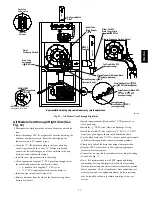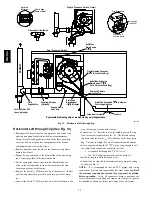
35
Changing Orifices for High Altitude
ELECTRICAL
SHOCK,
FIRE
OR
EXPLOSION
HAZARD
Failure to follow this warning could result in personal injury,
death, and/or property damage.
Turn OFF electric power (at disconnect) and gas supply (at
manual valve in gas line) when installing orifices. Installation
of orifices requires a qualified service technician.
!
WARNING
NOTE
: Main burner orifices can be changed for high altitudes.
1. Disconnect gas line from gas valve.
2. Remove manifold from furnace.
3. Remove the orifices from the manifold and replace them
with properly sized orifices.
4. Tighten orifices so it is seated and gas tight. (See Fig. 35)
5. Reinstall manifold. Ensure burners do
NOT
bind on new
orifices.
Natural Gas Input Rating Check
SEE CHECKS AND ADJUSTMENTS, Natural Gas Input
Rating Check
in this manual.
Measure from face of orifice
to the back side of the
manifold.
1.11
″
(28.2mm)
1.21
″
(30.8mm)
A07725
Fig. 35 -- Changing Orifices
Final Gas Piping Check
FIRE OR EXPLOSION HAZARD
Failure to follow this warning could result in personal injury,
death, and/or property damage.
Never test for gas leaks with an open flame.
Use a
commercially available soap solution made specifically for the
detection of leaks to check all connections.
A fire or
explosion could result causing property damage, personal
injury and/or loss of life.
!
WARNING
1. The furnace and the equipment shut off valve must be dis-
connected from the gas supply piping system during any
pressure testing of that system at test pressures in excess of
1
/
2
″
PSIG. Close the manual shut--off valve before testing
at such pressures.
2. When installation is complete, test all pipe connections for
leaks with the gas pressure less than
1
/
2
″
PSIG to the gas
valve.
3. The furnace must be isolated from the gas supply system
by closing the equipment shut off valve during any pres-
sure testing of the gas supply system at test pressure equal
to or less than
1
/
2
″
PSI (3.5 kPa).
4. Apply a commercial soap solution to all joints to test for
leaks. Correct any leaks indicated by bubbles.
5. Correct even the smallest leak at once.
6. Check for leaks at gas valve and orifice connections to the
burner manifold while the furnace is operating.
ELECTRICAL WIRING
Power Supply Wiring
The furnace
MUST
be electrically wired and grounded in
accordance with local codes, or in the absence of local codes with
the latest edition of The National Electric Code, ANSI NFPA 70
and/or The Canadian Electric Code CSA C22.1.
The power supply to the furnace connections must be between
104 VAC and 127 VAC during furnace operation for acceptable
performance.
Field wiring connections must be made inside the furnace
connection box. A suitable strain relief should be used at the
point the wires exit the furnace casing.
Copper conductors shall be used.
Line voltage wires should
conform to temperature limitation of 63
°
F (35
°
C) rise and be
sized for the unit maximum amps stated on the rating plate. Add
the full load amps for potential field--installed accessories such as
electronic air cleaners and humidifiers that would receive power
from the furnace control. The furnace control is rated for a
maximum of 1.0 amp combined for EAC and HUM. Consult
NEC or local codes for proper wire and circuit sizing.
NOTE
: Furnace will not have normal operation if line polarity is
reversed. Check ALL field and control connections prior to
operation.
Junction Box (J- Box) Relocation
The J--box is installed on left side of casing. An alternate j--box
location on right side can be used.
1. Remove bag containing two hole plugs and two self tap-
ping screws from loose parts bag in blower compartment.
2. Remove two screws holding J--Box to casing.
3. Move large hole plug from right to left J--Box location.
4. Clip wire tie holding J--Box wires.
5. Move J--Box to alternate location and attach using two self
tapping screws from bag.
6. Apply two hole plugs from bag at left J--Box location.
Thermostat
Thermostat location has an important effect on the operation of
the unit. Follow instructions included with thermostat for correct
mounting and wiring.
Low voltage connections to furnace must be made on terminal
board of furnace control.
Heat anticipator setting will need to be measured if 24VAC
humidifier is installed. Measure current in series from R to W at
the thermostat. Be sure 24VAC humidifier is wired up to control.
Allow furnace to operate for 2 minutes before recording the AC
amperage reading. Set anticipator on thermostat to recorded
value.
PG9Y
AA




































